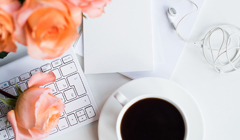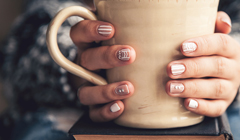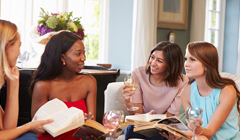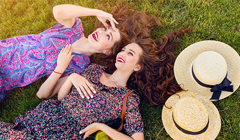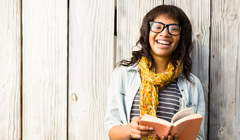- Tania Pryputniewicz
- Testaments to Resiliency: Deferred Motherhood, Divorce and Peace in the Artwork of Katherine Fraser

 In the poetic artist statement posted on your website www.katherinefraser.com, you posit a striking truth: “Though my subjects usually stand alone, I am less interested in loneliness than in the way being alone makes us feel most alive and connected to our true nature.” Can you talk about this notion in relation to the images of pregnancy you’ve documented? In looking at “Making Peace,” (view paintings here at The Fertile Source) I’m struck by the gravity and joy depicted simultaneously—the hint of blue across the rim of belly, the black and white butterflies flitting up behind the pregnant figure where she cannot see them. How did you settle on the phrase, “What the heart wants?”
In the poetic artist statement posted on your website www.katherinefraser.com, you posit a striking truth: “Though my subjects usually stand alone, I am less interested in loneliness than in the way being alone makes us feel most alive and connected to our true nature.” Can you talk about this notion in relation to the images of pregnancy you’ve documented? In looking at “Making Peace,” (view paintings here at The Fertile Source) I’m struck by the gravity and joy depicted simultaneously—the hint of blue across the rim of belly, the black and white butterflies flitting up behind the pregnant figure where she cannot see them. How did you settle on the phrase, “What the heart wants?”
I certainly don't need to tell you how many defining ideas about womanhood are inherent in pregnancy, fertility, and motherhood. As a 30-year-old, I am watching a lot of my friends grapple with all kinds of related issues, and it's clear that an inability to conceive is not just an obstacle in the desire to have a family, but also a blow to one's identity and sense of self-worth. This body of work was made just as I was facing the reality that my marriage was abusive and I needed to leave, and that I was doing that just at the time when, in all other ways, I felt completely ready to start a family.
I was really weighing my feelings about staying or going in that context, and "Making Peace" exemplifies the enormous sacrifice that I would have made if I had chosen to stay. In this image, the woman is nine months pregnant, but has no breasts at all, and her head is down in a gesture of defeat. The butterflies symbolize all of her hopes and aspirations flying away from her. Her heart wants to have a baby, but she has sacrificed absolutely everything else about herself to that end. I made a different choice for myself. By putting motherhood on the back burner for a while, I have been allowed to flourish in ways that I never imagined possible. Hopefully someday I will be a much better mother for it.
In “The Heart That Mends” I recognize a very real image of pregnancy. No one tells you before you have a baby how much of one’s blood is involved. I’ll keep it at that. This image, cocoon like and milkweed soft with its white background, doesn’t shy away from the bloodbeat beneath pregnancy and motherhood. How brave of you to depict that. How did you arrive at the pose, the figure’s facial expression, the background?
This was another case where I set out to make a painting about one theme, and other themes emerged in the process. I originally intended this painting to be a testament to resiliency. As I recovered from my divorce, I wanted to show that the heart can mend, cynicism can be cast off bit by bit, and love and beauty can bloom anew. This woman is fresh, and lovely, and her face is glowing with that hope for love, but there is still a shadow of fear. Her past hasn't been left behind completely, but she is mending. This tension of innocence and experience is something I meditate on often in my work.
The red in this painting reinforces that idea with its dual reference to roses and blood. The reference to blood then takes the painting in another direction- that of childbirth, and I again love that dual tension of gentle beauty with violence, and the miracle of birth with the gory reality of blood. It's an interesting contrast to the painting with the butterflies, where her vitality is drifting away, because here there is energy and life swirling expressively around the figure.
Talk to us about “Fantasy”—you’ve opened a male “Pandora’s Box” it seems, suggesting male pregnancy and other haunting possibilities. How did this imagery come to you? When did you know you’d be painting a child emerging nested within the male figure? Can you talk about the process of painting this image and what you see in it?
Well, male pregnancy never entered my thoughts here, but it is kind of a reverse of the classic male fantasy of a generic wife and kids. When I painted this I felt like my clock was ticking, but my marriage was crumbling, so I painted the fantasy of faceless man carrying a baby. It was a way for me to depict what I wanted, but acknowledge that my husband wasn't the right man for that role. The identity of the man in this painting isn't important anyway, because it's all about the fantasy of the baby and the "idea" of having it all.
It was a painful painting for me to look at for a long time, because it represented to me everything I left behind when I got divorced, but now I see this as a painting of the man I hope lies in my future. Admittedly, there's also a little humor in it. Whenever I see a man walking down the street with one of those baby bjorns hanging from his chest, I can't help thinking how it looks so mesmerizingly appealing to other women, but in reality, the wife is probably carrying and caring for the child the other 95% of the time.
The deep blues and blacks of “Real and Imagined” suggest a certain sorrow, yet again, there’s your signature balancing duality present—I sense a calmness in the woman’s expression as she holds a child penciled in, drafting plans of a house in the backdrop. A child and home of one’s own are two images our culture certainly puts stock in as a measure of any woman’s contentment. Or maybe not--can you talk about which part of the female psyche you were exploring?
This painting was about reconciling my conflicting feelings about leaving my unhealthy marriage right at the point where, on paper, I had everything in place to start a family. I was young, and I had a husband, and a house, and health insurance, and I wanted a baby more than anything, but it had to stay a fantasy because the time wasn't right in other, more meaningful ways. Yes, I was using the idea of a house and a baby as symbols of success, because they are things every woman is supposed to want. For me the house was real, and the baby was imagined, but neither could offer me happiness or contentment at that time. This woman is deeply sad, but also resolute, because she knows what she has to do. The Blue of the background gives me a solemn sense of peace.
When I look at “The Modern Woman” I of course think of O’Keeffe’s freedoms, her choices as an artist. When I look at this painting, I think, “What are this young woman’s choices?” I’m curious about what she’s holding and why. What she will or will not create. What were your questions as you painted?
This painting absolutely refers to Georgia O'keefe, in it's color palette and in the use of the skull, and also in honor of the way history questions her fulfillment as an artist, a wife, and a woman. The woman in this painting is young, and potentially fertile, but she is holding a horse skull, a reference to death, or barrenness. She could be wearing white because she is a bride, or to symbolize her innocence, but either way, her face shows the gravity of the pressure to reproduce, or simply to fill an external concept of womanhood and femininity. The grid and numbers in the background refer to a calendar, and a woman's monthly cycle, but are also meant to convey the passing of time. The title, "The Modern Woman" suggests that she might be above such traditional expectations, but her face lacks that Confidence. I wanted the painting to convey the sense that she is on the cusp of these questions.
Where do you see your work in the lineage of women painters attempting to mirror the reality of womens’ experiences? Who are your mentors and/or sources of inspiration (living or not)?
I've never been a fan of "Feminist" art. I'm interested in the universal experience of humanity, and in storytelling. I paint women because I am a woman, and it's the truest to my own experience, but my deepest goal is to create images that will resonate with everyone, male and female, young and old. I look to a lot of photography for inspiration, and my list of favorites is definitely dominated by women; Diane Arbus, Mary Ellen Mark, Sally Mann, Francesca Woodman... I think women have the ability to look at any subject unflinchingly, but often with an additional layer of sympathy or sensitivity. In viewing their work, I get the sense that these women care, on some level, about their subjects, as I do mine (even though mine are invented).
There are a number of women painters who I find compelling that use a good deal of aggression in their work, like Jenny Saville or Lisa Yuskevage, but it doesn't influence my paintings at all. In my own work, I actually deliberately avoid making images that are raw. I try to filter my ideas through layers of symbolism and narrative so that I get away from making art that is purely self-expression, and move toward something that has more versatility in its ability to communicate. My feeling is that I want to invite people to look at Women and their issues more closely, but if I make the viewer too uncomfortable, they will only look away. I love to explore themes that are painful and uncomfortable, but I want to do it in such a way that it draws people in and engages them. This opportunity to connect with people, to communicate, is a huge part of why I make art. It's not enough for me to just make the paintings and express myself, I need the paintings to get out and have a life of their own.
Where are you currently fascinated in your work? What other parts of the soul do you foresee yourself documenting in future work?
I never consciously pursue an interest in a certain theme, my process is much more intuitive. I work on a number of paintings at once, and by going back and forth like this, themes start to emerge, and the work grows up as a body. What makes this way of working fun is that I feel like I am in dialogue with the work; it's a combination of actively making decisions, and of being quiet and letting the paintings tell me what they need, and ultimately volumes are revealed to me about myself.
Right now, for example, I am working on a group of paintings that are turning out to use a lot of bird, feather, and boat imagery, particularly boats on land. I didn't set out to do this because boats symbolize something particular to me, but now I can stand back and look at them and see that my subconscious is trying to tell a story. It might be too soon to say, but since I have finally concluded the emotional transition of putting my marriage behind me, and quit my job to pursue painting full time, I think that the boats might be symbols for the latent potential that I sense I am just now tapping into.
Looking at the paintings I make is a little like interpreting dreams. My hope is that the universality of these symbols will allow each viewer the freedom to create their own narrative for what is occurring in the painting. For this reason, my paintings are not depictions of specific memories that I have, but they are recreations of feelings that I have had at certain times in my life. I try very hard to make the images open-ended so that there can be many interpretations.
I feel excited to see what will come next!
Writing Status Badges












Writing Status Badges












Featured Members (7)
Writing Status Badges






















